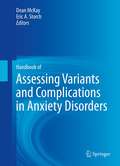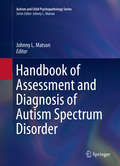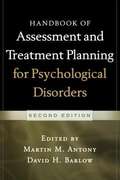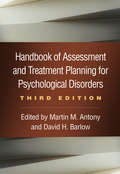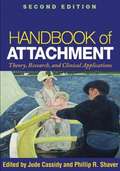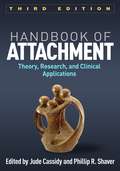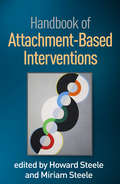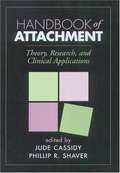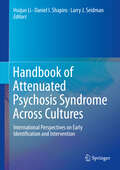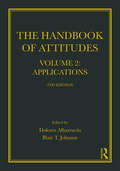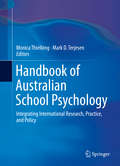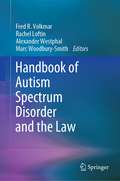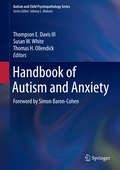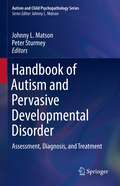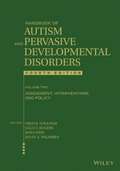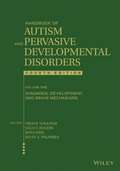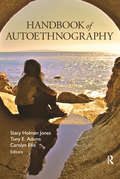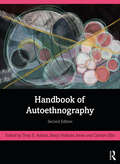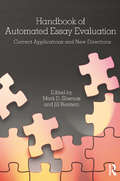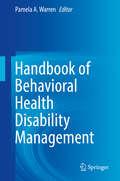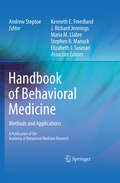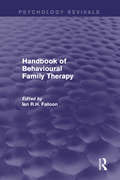- Table View
- List View
Handbook of Assessing Variants and Complications in Anxiety Disorders
by Dean Mckay Eric A. StorchThe Handbook of Assessing Variants and Complications in Anxiety Disorders assembles current findings on assessment methods and applies them to common complicating factors, including comorbid personality and behavioral problems. Chapters examine innovative approaches to assessment of anxiety in children and adults, provide leading insights into timely topics (e.g., school refusal, self-injurious behaviors), and analyze strengths and weaknesses of widely used assessment tools. In clarifying the assessment process, contributors give readers a clear perspective on choosing treatment options in keeping with the trend toward targeted, evidence-based practice, and pinpoint needs for further research. The Handbook's coverage spans the anxiety spectrum, including areas such as: Assessment of social and generalized anxiety disorder.Neuropsychological assessment of obsessive-compulsive disorder.Intelligence testing and treatment planning with children.Assessment of substance abuse and dependence in anxiety disorders.Personality disorder assessment in clients with anxiety disorders.Functional assessment of comorbid and secondary disorders: identifying conditions for primary treatment.The Handbook of Assessing Variants and Complications in Anxiety Disorders is an essential reference for researchers, scientist-practitioners, and graduate students in clinical child, school, and developmental psychology; social work; psychiatry; psychotherapy; counseling; and pediatrics. And its companion volume, the Handbook of Treating Variants and Complications in Anxiety Disorders, translates these findings to the next stage of care.
Handbook of Assessment and Diagnosis of Autism Spectrum Disorder (Autism and Child Psychopathology Series #0)
by Johnny L. MatsonThis handbook details best practices and discusses ongoing challenges in assessment and diagnosis of autism spectrum disorder (ASD). Chapters address assessment and diagnostic protocols, developmental considerations in ASD assessment, and issues concerning comorbid psychological and medical conditions. Various aspects of the disorder are emphasized throughout the handbook - from assessment in adolescent and adult populations to the latest findings in neuropsychology. The book concludes with future directions for research and clinical applications, focusing on universal screening, improved assessment methods, and earlier and more accurate diagnosis.Topics featured in this handbook include:Types of ASD assessment. Report writing for ASD evaluations.Stress and satisfaction in the diagnostic process.Clinical and neuropsychological perspectives from comorbid diagnosis of ASD and ADHD.Executive functions in ASD.The Handbook of Assessment and Diagnosis of Autism Spectrum Disorder is an essential reference for researchers, clinicians, professionals, and graduate students in clinical child and school psychology, child and adolescent psychiatry, and social work as well as rehabilitation medicine/therapy, behavioral therapy, pediatrics, and educational psychology.
Handbook of Assessment and Treatment Planning for Psychological Disorders, 2/e
by David Barlow Martin AntonyWidely regarded as a premier clinical reference, this book provides state-of-the-science tools for conducting effective assessments and using the results to plan and monitor evidence-based interventions. Leading authorities present proven approaches to screening and assessment for specific psychological problems. They offer practical guidance and case examples to help clinicians select the best measures for different populations and assessment purposes. Recommended instruments and procedures are described, including applications for managed care and primary care settings. Many of the chapters feature detailed tables that compare and contrast relevant measures. New to This Edition Thoroughly updated with new instruments and research findings. Chapter on the role of assessment in evidence-based treatment. Additional disorder-specific chapter impulse control disorders. Chapter explaining how to evaluate the reliability and validity of a measure.
Handbook of Assessment and Treatment Planning for Psychological Disorders, Third Edition
by David H. Barlow Martin M. AntonyThis authoritative clinical reference and text--now revised and updated with 50% new content--presents the assessment tools and strategies that every evidence-based psychotherapy practitioner needs. Unlike most assessment texts, the volume is organized around specific clinical problems. It explains how to select and use the best measures to assess clients' symptoms, generate diagnoses, plan appropriate treatments, and monitor progress. Clinician- and student-friendly features include tables comparing and contrasting relevant measures, sample forms, and case examples. Every chapter addresses considerations for primary and managed care settings. New to This Edition *Chapters on new topics: assessment of well-being and transdiagnostic assessment. *New chapters on core topics: eating disorders, personality disorders, and insomnia. *Updated throughout with DSM-5 diagnostic changes, new and updated instruments, current research, and increased attention to transdiagnostic concerns. *Expanded coverage of obsessive–compulsive and related disorders. See also Clinical Handbook of Psychological Disorders, Fifth Edition, edited by David H. Barlow, which presents evidence-based treatments step by step.
Handbook of Assessment in Mindfulness Research
by Nirbhay N. Singh Richard J. Siegert Christian U. Krägeloh Oleg N. MedvedevThis handbook provides comprehensive coverage of assessment instruments used in mindfulness research. It discusses traditional and modern approaches used to develop psychometric measures and to establish their reliability and validity, such as classical test theory, item response theory and Rasch model, generalizability theory, facet benchmarking, and network analysis. The handbook provides information on conceptual foundations, development, and psychometric properties of assessment instruments used to measure mindfulness in children, adolescents, and adults. In addition, it provides similar information on scales used in specific contexts and for various purposes. It reviews behavioral, cognitive, and psychophysiological assessment measures of mindfulness. The handbook examines a broad range of psychological, physical health, and mental health, and related measures that are used in mindfulness research. This reference work enables researchers to choose appropriate measurement tools fora broad range of mindfulness research.Key areas of coverage include:Nature and theoretical foundations of assessment.Origins and definitions of mindfulness.Mindfulness scales for children and adolescents.Mindfulness scales for adults.Mindfulness scales for specific contexts and purposes.Mindfulness and Buddhist-related scales.Behavioral assessments of mindfulness.Cognitive and psychophysiological assessments of mindfulness. The Handbook of Assessment in Mindfulness Research is an essential reference for researchers, professors, and graduate students as well as clinicians, therapists, and other mental health practitioners in clinical psychology and affiliated medical and mental health disciplines, including complementary and alternative medicine, social work, occupational and rehabilitation therapy.
Handbook of Attachment, Second Edition
by Jude Cassidy Phillip ShaverFrom foremost authorities, this comprehensive work is more than just the standard reference on attachment-it has "become indispensable" in the field. Coverage includes the origins and development of attachment theory; biological and evolutionary perspectives; and the role of attachment processes in personality, relationships, and mental health across the lifespan. New to This Edition A decade's worth of major theoretical and empirical advances. Chapters on foster care, attachment in middle childhood, affect regulation, divorce, the neuroscience of attachment, and attachment in later life. Findings on disorganized attachment and psychopathology.
Handbook of Attachment, Third Edition: Theory, Research, and Clinical Applications
by Jude Cassidy Phillip R. ShaverWidely regarded as the state-of-the-science reference on attachment, this handbook interweaves theory and cutting-edge research with clinical applications. Leading researchers examine the origins and development of attachment theory; present biological and evolutionary perspectives; and explore the role of attachment processes in relationships, including both parent-child and adult romantic bonds. Implications for mental health and psychotherapy are addressed, with reviews of exemplary attachment-oriented interventions for children and adolescents, adults, couples, and families. Contributors discuss best practices in assessment and critically evaluate available instruments and protocols. New to This Edition *Chapters on genetics and epigenetics, psychoneuroimmunology, and sexual mating. *Chapters on compassion, school readiness, and the caregiving system across the lifespan. *Chapter probing the relation between attachment and other developmental influences. *Nearly a decade's worth of theoretical and empirical advances.
Handbook of Attachment-Based Interventions
by Howard Steele Miriam SteeleThe first volume to showcase science-based interventions that have been demonstrated effective in promoting attachment security, this is a vital reference and clinical guide for practitioners. With a major focus on strengthening caregiving relationships in early childhood, the Handbook also encompasses interventions for school-age children; at-risk adolescents; and couples, with an emphasis on father involvement in parenting. A consistent theme is working with children and parents who have been exposed to trauma and other adverse circumstances. Leading authorities describe how their respective approaches are informed by attachment theory and research, how sessions are structured and conducted, special techniques used (such as video feedback), the empirical evidence base for the approach, and training requirements. Many chapters include illustrative case material.
Handbook of Attachment: Theory, Research, and Clinical Applications
by Jude Cassidy Phillip R. ShaverIn clinical literature on the effects of early parent-child relationships, including troubled and abusive relationships, attachment theory is prominent.
Handbook of Attenuated Psychosis Syndrome Across Cultures: International Perspectives on Early Identification and Intervention
by Huijun Li Larry J. Seidman Daniel I. ShapiroThis handbook examines state-of-the-art research and clinical findings on attenuated psychosis syndrome (APS) across the globe. It addresses symptoms, assessment methods, and treatment approaches as they differ and converge across countries and cultures. The handbook explores how the illness impairs many aspects of daily functioning, with high rates of suicide and a reduced life span. It details how early detection is critical and may greatly reduce the public health burden of the illness. Chapters describe the early identification and intervention efforts that are currently underway across the world. The book offers international findings from prominent researchers, elaborating culturally relevant illness symptoms, help-seeking behaviors, and assessment and intervention strategies. In addition, chapters illustrate wide variations in symptom expression and experience, reinforcing the necessity of culturally attuned practice in patient-centered care. The book concludes by examining the implications – challenges and opportunities – for future research and clinical practices from an international perspective.Topics featured in the Handbook include:Barriers to service in low-resourced countries. The role of traditional or culturally acceptable care in developing early intervention models. The reliability and validity of tools for assessing and identifying APS.Possible medical diagnoses that can present with APS symptoms and how to differentiate these conditions from APS. The Handbook of Attenuated Psychosis Syndrome Across Cultures is a must-have resource for researchers, professors, clinicians, and related professionals as well as graduate students in child and school psychology, psychiatry, social work, and related disciplines.
Handbook of Attitudes, Volume 2: 2nd Edition
by Dolores Albarracin Blair T. JohnsonAttitudes are evaluations of people, places, things, and ideas. They help us to navigate through a complex world. They provide guidance for decisions about which products to buy, how to travel to work, or where to go on vacation. They color our perceptions of others. Carefully crafted interventions can change attitudes and behavior. Yet attitudes, beliefs, and behavior are often formed and changed in casual social exchanges. The mere perception that other people—say, rich people— favor something may be sufficient to make another person favor it. People’s own actions also influence their attitudes, such that they adjust to be more supportive of the actions. People’s belief systems even change to align with and support their preferences, which at its extreme is a form of denial for which people lack awareness. These two volumes of The Handbook of Attitudes provide authoritative, critical surveys of theory and research about attitudes, beliefs, persuasion, and behavior from key authors in these areas. This second volume covers applications to measurement, behavior prediction, and interventions in the areas of cancer, HIV, substance use, diet, and exercise, as well as in politics, intergroup relations, aggression, migrations, advertising, accounting, education, and the environment.
Handbook of Augmented Reality Training Design Principles
by Laura G. Militello Christen E. Sushereba Sowmya RamachandranThe Handbook of Augmented Reality Training Design Principles is for anyone interested in using augmented reality and other forms of simulation to design better training. It includes eleven design principles aimed at training recognition skills for combat medics, emergency department physicians, military helicopter pilots, and others who must rapidly assess a situation to determine actions. Chapters on engagement, creating scenario-based training, fidelity and realism, building mental models, and scaffolding and reflection use real-world examples and theoretical links to present approaches for incorporating augmented reality training in effective ways. The Learn, Experience, Reflect framework is offered as a guide to applying these principles to training design. This handbook is a useful resource for innovative design training that leverages the strengths of augmented reality to create an engaging and productive learning experience.
Handbook of Australian School Psychology
by Monica Thielking Mark D. TerjesenThis handbook addresses the current state and practice of school psychology with a focus on standards unique to Australia, including historical, legal, ethical, practical, and training factors. It provides a compilation of the most current research-based practices as well as guidelines for evidence-based assessment and intervention for common conditions (e. g. , autism, depression, learning disabilities) and for delivering appropriate services to targeted student populations (e. g. , LGBT, gifted, medical issues). Chapters discuss the application of national and international school psychology practices within the Australian educational and psychological structure. The handbook also examines the lack of formal resources specific to Australia's culture and psychology systems, with its unique mix of metropolitan cities and the vast geographic landscape that spans regional and remote areas. It offers numerous case studies and innovative school mental health programs as well as recommendations for professional development and advocacy that are unique to Australian school psychology. Topics featured in this Handbook include: Evidence-based assessment and intervention for dyscalculia and mathematical disabilities. Identification and management of adolescent risk-taking behaviors and addictions. Understanding and responding to crisis and trauma in the school setting. Prevention and intervention for bullying in schools. Class and school-wide approaches to addressing behavioral and academic needs. The role of school psychologists in the digital age. Practical advice for school psychologists facing complex ethical dilemmas. The Handbook of Australian School Psychology is a must-have resource for researchers, scientist-practitioners, and graduate students in child and school psychology, social work, and related fields that address mental health services for children and adolescents.
Handbook of Autism Spectrum Disorder and the Law
by Fred R. Volkmar Rachel Loftin Alexander Westphal Marc Woodbury-SmithThis book addresses an important and relatively neglected topic in the scientific literature: individuals with autism spectrum disorder (ASD) who have dealings with the legal system. It examines issues and implications for autistic people, who have a significant risk for engagement with the legal system in some capacity (e.g., witness/bystander, victim, or perpetrator).Key areas of coverage include:Autistic people as victims and perpetrators of criminal activities, including violence, stalking, sexual exploitation, and cybercrime. Risks for unlawful behavior in individuals with autism and Asperger's. Legal assessment issues, such as witness protection and postconviction diagnoses. Legal outcomes for autistic people, including case law, prevention, service provisions in correctional settings, and rights and support systems. The Handbook of Autism Spectrum Disorder and the Law is an essential, comprehensive resource that explores the risk for unlawful behaviors affecting autistitc people as victims and perpetrators, as well as related issues of assessment and treatment, and outcome. It is a must-have reference for researchers, clinicians/practitioners, and graduate students in psychology, psychiatry, social work, and law, as well as professionals in such related fields, as criminology/criminal justice and the legal system.
Handbook of Autism and Anxiety
by Thomas H. Ollendick Thompson E. Davis III Susan W. WhiteThe diagnosis of autism spectrum disorder (ASD) has evolved greatly since Asperger's day. And as our clinical understanding of this spectrum of disorders has grown, so has recognition of the connections between anxiety disorders and ASD--a welcome development, but also a source of confusion for many in the field. The Handbook of Autism and Anxiety brings together leading experts to explain this comorbidity, the diagnostic similarities and differences between the two disorders and the extent to which treatment for each can be coordinated for optimum results. Focusing on repetitive behaviors, social difficulties and fears as core components of anxiety disorders as well as ASD, contributors discuss specific symptoms in depth to aid in diagnosis. Assessment and treatment issues relevant to the autism-anxiety connection are considered in clinical and school contexts. And an especially timely conclusion details how key changes in the DSM-5 affect the diagnosis and conceptualization of each disorder. Key topics addressed in the Handbook include: Phenotypic variability in ASD: clinical considerations. Etiologic factors and transdiagnostic processes. Social worries and difficulties: autism and/or social anxiety disorder? Implementing group CBT interventions for youth with ASD and anxiety in clinical practice. Autism and anxiety in school settings. DSM-5 and autism spectrum disorder. The Handbook of Autism and Anxiety is an essential resource for researchers, clinicians/professionals and graduate students in child and school psychology, psychiatry, social work, education, clinical counseling and behavioral therapy.
Handbook of Autism and Pervasive Developmental Disorder: Assessment, Diagnosis, and Treatment (Autism and Child Psychopathology Series)
by Johnny L. Matson Peter SturmeyThis handbook provides a substantive foundation of autism theory and research, including a comprehensive overview, conceptualization, and history of autism spectrum disorder (ASD) and pervasive developmental disorder (PDD). This robust reference work integrates the broad scholarly base of literature coupled with a trenchant analysis of the state of the field in nosology, etiology, assessment, and treatment. Its expert contributors examine findings and controversies (e.g., the actual prevalence of autism) as well as longstanding topics of interest as well as emerging issues from around the globe. In addition, the handbook describes multiple assessments, diagnoses, interventions and treatments for autism and PDD. It addresses such key topics as assessment of core symptoms and comorbidities, risk factors, epidemiology, diagnostic systems, neuroscience as well as issues regarding family adaptation. In addition, the handbook explores the rapidly evolving and expanding topics of medications, diets, fringe and harmful treatments, applied behavior analysis, and early intensive behavioral interventions.Key areas of coverage include:Survey of diagnostic criteria and assessment strategies for autism and pervasive developmental disorder.Genetic, behavioral, biopsychosocial, and cognitive models of autism assessment and treatment.Psychiatric disorders in individuals with ASD.Theory of mind and facial recognition in persons with autism.Diagnostic instruments for assessing core features and challenging behaviors in autism and PDD.Evidence-based psychosocial, pharmacological, and integrative treatments for autism and other developmental disabilities.Interventions specifically for adults with ASD.Training issues for professionals, parents, and other caregivers of individuals with autism and developmental disabilities.Review of findings of successful and promising therapies coupled with guidance on how to distinguish between dubious and effective treatments for autism and PDD. The handbook is an indispensable resource for researchers, professors, graduate students as well as clinicians, therapists, and other practitioners in clinical child and school psychology, child and adolescent psychiatry, social work, special education, behavioral rehabilitation, pediatric medicine, developmental psychology, and all allied disciplines.
Handbook of Autism and Pervasive Developmental Disorders, Assessment, Interventions, and Policy
by Sally J. Rogers Fred R. Volkmar Rhea Paul Kevin A. PelphreyThe latest and most comprehensive resource on autism and related disordersSince the original edition was first published more than a quarter-century ago, The Handbook of Autism and Pervasive Developmental Disorders has been the most influential reference work in the field. Volume 2 of this comprehensive work includes a wealth of information from the experts in their respective specialities within the larger field of autism studies: Assessment, Interventions, and Social Policy Perspectives.Within the three sections found in Volume 2, readers will find in-depth treatment of:Screening for autism in young children; diagnostic instruments in autism spectrum disorders (ASD); clinical evaluation in multidisciplinary settings; assessing communications in ASD; and behavioral assessment of individuals with autism, including current practice and future directionsInterventions for infants and toddlers at risk; comprehensive treatment models for children and youth with ASD; targeted interventions for social communication symptoms in preschoolers with ASD; augmentative and alternative communication; interventions for challenging behaviors; supporting mainstream educational success; supporting inclusion education; promoting recreational engagement in children with ASD; social skills interventions; and employment and related services for adults with ASDSupporting adult independence in the community for individuals with high functioning ASD; supporting parents, siblings, and grandparents of people with ASD; and evidence-based psychosocial interventions for individuals with ASDSpecial topic coverage such as autism across cultures; autism in the courtroom; alternative treatments; teacher and professional training guidelines; economic aspects of autism; and consideration of alternative treatmentsThe new edition includes the relevant updates to help readers stay abreast of the state of this rapidly evolving field and gives them a guide to separate the wheat from the chaff as information about autism proliferates.
Handbook of Autism and Pervasive Developmental Disorders, Diagnosis, Development, and Brain Mechanisms
by Sally J. Rogers Fred R. Volkmar Rhea Paul Kevin A. PelphreyThe newest edition of the most comprehensive handbook on autism and related disordersSince the original edition was first published more than a quarter of a century ago, The Handbook of Autism and Pervasive Developmental Disorders, Volume 1: Diagnosis, Development, and Brain Mechanisms, has been the most influential reference work in the field of autism and related conditions. The new, updated Fourth Edition takes into account the changes in the disorders' definitions in the DSM-V and ICD-10 that may have profound implications for diagnosis and, by extension, access to services. Along with providing practical clinical advice--including the role of psychopharmacology in treatment--the handbook codifies the ever-expanding current body of research throughout both volumes , offering a wealth of information on the epidemiology of autism and the genetic, environmental, biochemical, social, and neuropathological aspects of the disorder. Volume 1 includes: Information on outcomes in adults with autism spectrum disordersA range of issues and interventions important from infancy, though adolescence and beyond for individuals with autism spectrum disordersCurrent information about play development, including skills, object play, and interventionsCoverage of the state of genetic, biochemical, and neuropathological autism researchChapters on psychopharmacology and medical care in autism and related conditionsThe new edition includes the relevant updates to help readers stay abreast of the state of this rapidly evolving field and gives them a guide to separate the wheat from the chaff as information about autism proliferates.
Handbook of Autoethnography
by Tony E. Adams Stacy Holman Jones Carolyn EllisIn this definitive reference volume, almost fifty leading thinkers and practitioners of autoethnographic research—from four continents and a dozen disciplines—comprehensively cover its vision, opportunities and challenges. Chapters address the theory, history, and ethics of autoethnographic practice, representational and writing issues, the personal and relational concerns of the autoethnographer, and the link between researcher and social justice. A set of 13 exemplars show the use of these principles in action. Autoethnography is one of the most popularly practiced forms of qualitative research over the past 20 years, and this volume captures all its essential elements for graduate students and practicing researchers.
Handbook of Autoethnography
by Tony E. Adams; Stacy Holman Jones; Carolyn EllisThe second edition of the award-winning Handbook of Autoethnography is a thematically organized volume that contextualizes contemporary practices of autoethnography and examines how the field has developed since the publication of the first edition in 2013. Throughout, contributors identify key autoethnographic themes and commitments and offer examples of diverse, thoughtful, effective, applied, and innovative autoethnography. The second edition is organized into five sections: In Section 1, Doing Autoethnography, contributors explore definitions of autoethnography, identify and demonstrate key features of autoethnography, and engage philosophical, relational, cultural, and ethical foundations of autoethnographic practice. In Section 2, Representing Autoethnography, contributors discuss forms and techniques for the process and craft of creating autoethnographic projects, using various media in/as autoethnography, and marking and making visible particular identities, knowledges, and voices. In Section 3, Teaching, Evaluating, and Publishing Autoethnography, contributors focus on supporting and supervising autoethnographic projects. They also offer perspectives on publishing and evaluating autoethnography. In Section 4, Challenges and Futures of Autoethnography, contributors consider contemporary challenges for autoethnography, including understanding autoethnography as a feminist, posthumanist, and decolonialist practice, as well as a method for studying texts, translations, and traumas. The volume concludes with Section 5, Autoethnographic Exemplars, a collection of sixteen classic and contemporary texts that can serve as models of autoethnographic scholarship. With contributions from more than 50 authors representing more than a dozen disciplines and writing from various locations around the world, the handbook develops, refines, and expands autoethnographic inquiry and qualitative research. This text will be a primary resource for novice and advanced researchers alike in a wide range of social science disciplines.
Handbook of Automated Essay Evaluation: Current Applications and New Directions
by Mark D. Shermis Jill BursteinThis comprehensive, interdisciplinary handbook reviews the latest methods and technologies used in automated essay evaluation (AEE) methods and technologies. Highlights include the latest in the evaluation of performance-based writing assessments and recent advances in the teaching of writing, language testing, cognitive psychology, and computational linguistics. This greatly expanded follow-up to Automated Essay Scoring reflects the numerous advances that have taken place in the field since 2003 including automated essay scoring and diagnostic feedback. Each chapter features a common structure including an introduction and a conclusion. Ideas for diagnostic and evaluative feedback are sprinkled throughout the book. Highlights of the book’s coverage include: The latest research on automated essay evaluation. Descriptions of the major scoring engines including the E-rater®, the Intelligent Essay Assessor, the Intellimetric™ Engine, c-rater™, and LightSIDE. Applications of the uses of the technology including a large scale system used in West Virginia. A systematic framework for evaluating research and technological results. Descriptions of AEE methods that can be replicated for languages other than English as seen in the example from China. Chapters from key researchers in the field. The book opens with an introduction to AEEs and a review of the "best practices" of teaching writing along with tips on the use of automated analysis in the classroom. Next the book highlights the capabilities and applications of several scoring engines including the E-rater®, the Intelligent Essay Assessor, the Intellimetric™ engine, c-rater™, and LightSIDE. Here readers will find an actual application of the use of an AEE in West Virginia, psychometric issues related to AEEs such as validity, reliability, and scaling, and the use of automated scoring to detect reader drift, grammatical errors, discourse coherence quality, and the impact of human rating on AEEs. A review of the cognitive foundations underlying methods used in AEE is also provided. The book concludes with a comparison of the various AEE systems and speculation about the future of the field in light of current educational policy. Ideal for educators, professionals, curriculum specialists, and administrators responsible for developing writing programs or distance learning curricula, those who teach using AEE technologies, policy makers, and researchers in education, writing, psychometrics, cognitive psychology, and computational linguistics, this book also serves as a reference for graduate courses on automated essay evaluation taught in education, computer science, language, linguistics, and cognitive psychology.
Handbook of Behavioral Criminology
by Vincent B. Van Hasselt Michael L. BourkeThis multidisciplinary volume assembles current findings on violent crime, behavioral, biological, and sociological perspectives on its causes, and effective methods of intervention and prevention. Noted experts across diverse fields apply a behavioral criminology lens to examine crimes committed by minors, extremely violent offenses, sexual offending, violence in families, violence in high-risk settings, and crimes of recent and emerging interest. The work of mental health practitioners and researchers is shown informing law enforcement response to crime in interrogation, investigative analysis, hostage negotiations, and other core strategies. In addition, chapters pay special attention to criminal activities that violate traditional geographic boundaries, from cyberstalking to sex trafficking to international terrorism.Among the topics in the Handbook:· Dyadic conceptualization, measurement, and analysis of family violence.· School bullying and cyberbullying: prevalence, characteristics, outcomes, and prevention.· A cultural and psychological perspective on mass murder.· Young people displaying problematic sexual behavior: the research and their words.· Child physical abuse and neglect.· Criminal interviewing and interrogation in serious crime investigations.· Violence in correctional settings.· Foundations of threat assessment and management. The Handbook of Behavioral Criminology is a meticulous resource for researchers in criminology, psychology, sociology, and related fields. It also informs developers of crime prevention programs and practitioners assessing and intervening with criminal clients and in correctional facilities.
Handbook of Behavioral Health Disability Management: Innovations In Prevention And Management
by Pamela A. WarrenThis authoritative handbook provides an up-to-date, interdisciplinary understanding of behavioral health issues and their management within disability systems. It examines today’s complex mismatches between providers, pinpointing related obstacles to relevant diagnosis, referrals, and care while making a solid case for better coordination and collaboration between primary care physicians and a wide range of disability and mental health specialists. Chapters review current findings on common job-related mental health and psychosocial issues, and guide readers through the tangle of insurance and legal concerns typically associated with disability cases. This elegant framework models more effective case management, leading to enhanced client satisfaction and functioning, and improved individual and system outcomes. Among the topics covered: A critique of the behavioral health disability system. Systemic-caused iatrogenic behavioral health disability and contradiction between diagnostic systems. Effective psychological evaluation and management of behavioral health concerns. Behavioral health disability and occupational medicine—concepts and practices. Physical therapy treatment and the impact of behavioral health concerns. A neuroplastic model of secondary contribution to behavioral health disability: theory and implications. With its practical solutions to large-scale health care problems, the Handbook of Behavioral Health Disability Management is necessary reading for health psychologists and professionals in rehabilitation, psychotherapy and counseling, occupational medicine, and allied fields as well as other stakeholders involved in the disability process.
Handbook of Behavioral Medicine
by Stephen B Manuck Andrew Steptoe Maria M. Llabre Kenneth Freedland J. Richard Jennings Elizabeth J. SusmanBehavioral medicine emerged in the 1970s as the interdisciplinary field concerned with the integration of behavioral, psychosocial, and biomedical science knowledge relevant to the understanding of health and illness, and the application of this knowledge to prevention, diagnosis, treatment, and rehabilitation. Recent years have witnessed an enormous diversification of behavioral medicine, with new sciences (such as genetics, life course epidemiology) and new technologies (such as neuroimaging) coming into play. This book brings together such new developments by providing an up-to-date compendium of methods and applications drawn from the broad range of behavioral medicine research and practice. The book is divided into 10 sections that address key fields in behavioral medicine. Each section begins with one or two methodological or conceptual chapters, followed by contributions that address substantive topics within that field. Major health problems such as cardiovascular disease, cancer, HIV/AIDs, and obesity are explored from multiple perspectives. The aim is to present behavioral medicine as an integrative discipline, involving diverse methodologies and paradigms that converge on health and well being.
Handbook of Behavioural Family Therapy (Psychology Revivals)
by Ian R.H. FalloonFirst published in 1988, behavioural family therapists worked in an area that had greatly changed since its inception over 20 years before. Growing out of the pioneering work of Gerald Patterson, Robert Paul Liberman, and Richard Stuart, whose backgrounds vary from psychology to psychiatry to social work, behavioural family therapy (BFT) had evolved to encompass systems theory, considerations of the therapeutic alliance, as well as approaches to accounting for and restructuring family members’ subjective experiences through cognitive strategies. As BFT had not been the ‘brain child’ of any one charismatic innovator, but rather of a wide array of clinicians and researchers developing and rigorously testing hypotheses, it is fitting that this much-needed summation of the field was a collaborative product of an array of well-established practitioners of the time. They discuss in Part 1 of the book the theoretical parameters of BFT, focusing on modular behavioural strategies, the indications for therapy, assessment of family problems, pertinent issues arising in clinical practice, and approaches to the problem of resistance to change. Contributors to Part 2 then apply theory to such clinical situations as ‘parent training’ and helping families cope with patients suffering from developmental disabilities, alcoholism, schizophrenia, senile dementia, as well as anxiety, obsessive-compulsive, and depressive disorders. Specific attention is also given to acute inpatient and primary health-care settings. While BFT had already proved quite effective in treating a great number of family problems, it was only in its infancy at the time of writing. As Falloon says in his overview ‘all exponents of the method are constantly involved with the process of refinement, each clinician is a researcher, each family member is a research subject, and each researcher is contributing to clinical advancement.’ This openness, in combination with a willingness to modify ‘sacred’ tenets of behaviourism while adapting proven techniques from other family therapies, made this title a landmark in its field. As such, it was not only of interest to all clinicians and researchers with a behavioural slant, but also to all family therapists who wished to challenge themselves to develop an integrative approach.
